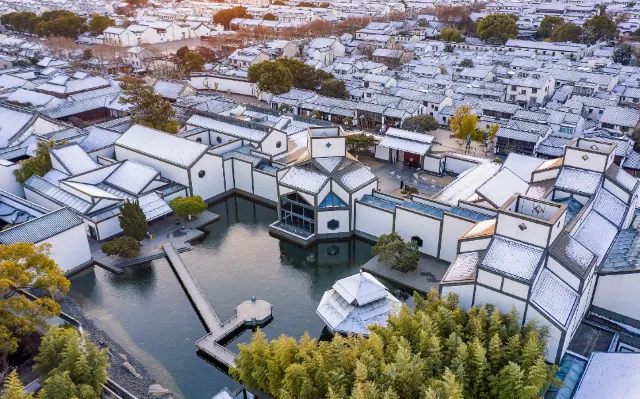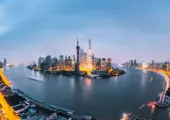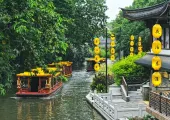Suzhou Travel Guide 2022
Catalogue
- 1. Things to know if you're visiting Suzhou for the first time
- 2. How to get to Suzhou from Shanghai Airports?
- 3. Transportation in Suzhou
- 4. Best Time to Visit Suzhou
- 5. Top 3 attractions in Suzhou
- 6. Food in Suzhou
- 7. Shopping in Suzhou
- 8. Local Customs in Suzhou
Show More
In China, Suzhou is synonymous with classical Chinese gardens, but this “Heaven on Earth” has so much more to offer. In the past, it was the home of high culture and sophistication, generations of scholars and artists drew inspiration from its natural and man-made beauties. Today visitors to modern Suzhou are still being wowed by its picturesque canals and ancient temples while enjoying contemporary comforts.

Suzhou is a major city and one of the oldest in the Yangtze Basin. Located in the south of Jiangsu province, it is surrounded by the Yangtze River in the north, Shanghai in the east, Lake Taihu in the west, and the ancient city of Hangzhou in the south. Celebrated for being a city of water, Suzhou has many waterways, streams, and water towns. The city is divided into 5 Urban Districts (Gusu, Wuzhong, Xiangcheng, Huqiu, and Suzhou Industrial Park) and is surrounded by 5 county-level cities.
Constructed in 514 BC, Suzhou has a long history of over 2500 years. Reaching its golden age in Ming and Qing Dynasties, today the city is one of the most developed in China. Beyond Suzhou’s economic significance, it is also the birthplace of Wu Culture which had a special contribution to Chinese culture. For visitors interested in unique local cultural heritage, watch a Kun Opera (Kunqu) performance, learn about silk production in the silk capital of China, or enjoy an ancient form of storytelling called Pingtan.
There are so many first-rate scenic spots in Suzhou, it is impossible to see them all if you only have a short time. Why not start with the astonishing 9 UNESCO World Heritage sites dotted around the city? Humble Administrator’s Garden, Lingering Garden, and Master of the Nets Garden to name just a few. Other amazing experiences visitors can have include a relaxing stroll around Pingjiang Road and its canals, visit the No. 1 Water Town in China – Zhouzhuang, and hike the serene Tianping mountain.
While Suzhou does not have a large airport of its own, visitors can arrive by air at Shanghai’s Hongqiao International Airport (SHA) or Pudong International Airport (PVG) and then take the train directly to Suzhou. Otherwise, it can be directly and easily reached by high speed and regular trains from all over the country. For getting around town, the metro, SND Trams, taxis, and special sightseeing buses are all affordable transportation options.
For anyone visiting Suzhou for the first time, the city’s historical and cultural richness certainly will not disappoint. But knowing when’s the best time to visit can definitely enhance to experience. Spring and Fall are the peak visiting seasons when Suzhou has the most pleasant weather. Sunny days and mildly warm temperatures are perfect for exploring the city’s many world-famous gardens and water towns. Note that national holidays in May, October, and Spring Festival periods will be extremely crowded.
Now you know when to go, but what about where to stay? Depending on the purpose of your visit, here are a few popular areas to consider. If you want to be in close proximity to top attractions, historic architecture, and a wide range of food and shopping venues, the Guanqian Street in the central Gusu District is a suitable option. Want to stay on one of Suzhou’s famous canals? Pingjiang Road is lined with old traditional-style buildings that have been converted into restaurants, cafes, and trendy shops. This is a great location to hop on a boat tour or take a relaxing stroll down the canal. For a quieter environment or for budget travelers, Wu Jiang District has less crowded streets and gives visitors the opportunity to immerse themselves in the local culture.
Suzhou is a great place to pick up a few souvenirs to remember your China trip. Top-quality local special products are plenty here, such as fine-quality silk, Suzhou embroidery, Biluochun green tea and Suzhou writing brush, etc. A tip on shopping: when buying specialty items like silk, jade, or tea that are pricy, it is advisable to have a local Chinese-speaking guide with you or purchase from official museums, department stores, or factory outlets to ensure quality. Also as with anywhere in China, bargaining is a normal practice.
While Suzhou is a popular tourist destination and major economic center in China, the city does not have its own airport. The closest airport is the Sunan Shuofang International Airport (WUX) which is 22 km (14 miles) away or 30 minutes by car. But it is a small size domestic airport with no direct nonstop flights from the U.S. or other international destinations.
That’s why those who do fly tend to prefer the nearby Shanghai Hongqiao International Airport (SHA) or Pudong International Airport (PVG) and then take the train directly to Suzhou. Both of these airports in Shanghai are major international airports easily reached from all over China and the world. Once arrived at either Shanghai airport, passengers heading to Suzhou can use many transportation options like a train (regular and bullet/high-speed trains), shuttle bus, or taxi. Out of the two airports, the most convenient is Shanghai Hongqiao International Airport (SHA). The airport's Terminal 2 is walkable from Hongqiao bullet train station which has trains that stop at Suzhou’s two bullet train stations (30 minutes journey). If you arrive at Pudong International Airport (PVG) out of necessity, factor in roughly an hour additional travel time as you’ll need to first travel across Shanghai to reach the bullets train station that links Suzhou.
Other transport options from Shanghai to Suzhou include regular trains which will take 90 minutes, long-distance coaches (Suzhou South Gate Station) that take a minimum of 90 minutes, and taxis (approximately 75 to 105 minutes). There are two additional airports: Hangzhou Xiaoshan International Airport and Nanjing Lukou International Airport, which also have transfer options to Suzhou.
Instead of flying, traveling to Suzhou by train from other parts of China is also a convenient option. In addition to numerous regional and local trains, visitors can reach Suzhou quickly via bullet / high-speed trains from Beijing in 5-6 hours (or 13-21 hours by regular train), or from Xi’an in 6-10.5 hours (or 14-23 hours by regular train).
As one of the most developed cities in China, Suzhou has a comprehensive public transport system that ensures convenient and affordable travel for residents and tourists. Because the city attracts millions of visitors each year, the local government authorized five special sightseeing bus routes (Y1, Y2, Y3, Y4, and Y5) to allow easy exploration of many scenic spots.
For example, Route Y1 departs from Suzhou Railway Station to Humble Administrator's Garden (Zhuo Zheng Yuan), Lion Grove Garden, and Silk Museum;
Route Y4 hits destinations like Beisi Pagoda, Ancient Town of Mudu, and Taiping Mountain.
Most fares start at 2 RMB and all routes depart from the Suzhou Railway Station (27 Chezhan Road, Gusu). It is worth noting that, there is no fare collector on the bus, so ensure that you have loose change before boarding.
Suzhou has a modest-size Metro system with 4 lines and 38 stations, but plans for more lines are in the works. The ticket price ranges from 2-8 RMB according to the distance traveled. In addition, there is also the SND Tram which operates 2 tram lines in Suzhou, the fare is 2 RMB per person for a single ride.
If traveling by taxi is more your style, you’ll be happy to hear that finding a taxi in Suzhou is generally very easy, though it is still good to avoid rush hours. All taxis are metered and the starting fare is 10 RMB. Taxis can be flagged down on the street, and an available taxi can be identified when the dash light is lit in green. As taxi drivers rarely speak or read English, so it is best to prepare your destination name in Chinese or in Pinyin.
Suzhou has a subtropical monsoon climate which means four distinct seasons with wet and hot summers, and cold and cloudy winters. With summer lasting from June to September, the hottest month is July when temperature sometimes reaches 38 °C (100 °F). Summer is also the rainy period when the air is humid, and rainfall increases significantly. Winter in Suzhou is between December and February, the temperature could plunge to 0 °C (33 °F) from late January to early February. While it rarely snows, the region still feels quite cold and humid. Hence weather-wise the best times to visit Suzhou is Spring or Fall when it is generally sunny, cool, and dry.
Due to the pleasant weather, Spring and Fall are the peak tourist seasons in Suzhou. Also, Spring is the best time to view peach, plum, and cherry blossoms. People rush to the area’s gardens, parks, and lakes to enjoy the great outdoors. Beside Spring and Fall, other peak times for Suzhou are national holiday periods when millions of domestic tourists tend to descend on the city. To avoid extreme crowds, pick your dates carefully. Also, prices for hotels and flights will be most expensive during these times. Major Chinese holidays are the Chinese Spring Festival, Labor Day, and National Day etc.
Known as “Heaven on Earth” in China, Suzhou has a plethora of attractions to enchant visitors. From its exquisite gardens, charming water towns to architectural masterpieces, it will take days to explore and appreciate.
Out of all the stunning gardens in Suzhou, the number one must-see has got to be the Humble Administrator’s Garden. A UNESCO World Heritage Cultural Site, this garden is considered one of the largest in Suzhou and one of China’s four most famous gardens. Strolling around its serene ponds, shapely rockery, and picturesque pavilions, visitors are transported back in time to a tranquil and past world. If you want to see more classical gardens, consider Garden of Harmony, Master of the Nets Garden, and Lingering Garden.
For Architecture lovers, be sure to stop by the Suzhou Museum and marvel at the perfect fusion of traditional southern Chinese architecture style and modern aesthetics designed by acclaimed architect I.M. Pei. The museum is also home to over 15,000 precious cultural relics including porcelains and gold and silverware. The museum is a short walk away from the Humble Administrator’s Garden and Lion Grove Garden. Alternatively buses 112 and 202 can also take you directly there.
Built on a network of hundreds of waterways, it’s no surprise that Suzhou is also famous for its many well-preserved ancient water towns. Either exploring on foot or by boat, it's yet another great experience that visitors will find unforgettable. The most visited is the Zhouzhuang water town, built in the Ming and Qing Dynasties. Considered as one of the “Six Ancient Towns” in the Jiangnan region, it is renowned for its stone-paced bridges and folk customs like Kunqu Opera. Other ancient water towns worth exploring include Tongli Town, Luzhi Town, and Mudu Ancient Town.
Similar to its neighbor Shanghai, cuisine in Suzhou is famed for its mildly sweet and delicate flavors, fresh ingredients, and impeccable presentations. A famous regional creation is the Sweet and Sour Mandarin Fish, or also known as the Squirrel-Shaped Mandarin Fish. The dramatic orange color and spiky appearance of the fish are created when boneless whole carp is coated in yolk paste and deep-fried, then covered with sweet and sour sauce. Its crispy yet soft texture together with the flavorful sweet tangy taste is what made this dish a required dish at any banquet or family gathering.
If you have time in the morning, try to eat like a local by grabbing a plate of Pan-Fried Bun or Soup Dumpling (Xiaolongbao). While the Pan-fried bun is stuffed with various fillings like minced pork and has a crispy golden bottom, the soup dumpling is steamed, chewy, and filled with a hot, flavorful soup.
Another famous local culinary gem is the Cherry Pork (Yingtao Rou) where pork is roughly cut to the size of a cherry and covered in a red sauce. When served on a bed of green veggies, the dish has a pleasing appearance of fresh cherries just picked from the tree.
Not sure what to bring home from your Suzhou trip? As a historical and cultural city, tourists can find a dizzying array of specialty products like fine-quality silk, Suzhou embroidery - regarded as a pearl of Chinese art, Biluochun green tea – famed in China for its fragrant aroma and mellow taste, Suzhou writing brush, jade carvings, and Tao Hua Wu woodcut New Year pictures, etc.
In terms of where to buy these items, Guanqian Street is one of the oldest shopping streets in Suzhou, with a history of over 150 years. Situated in the historic old town, this pedestrianized shopping street has a concentration of century-old shops, famous old-brand restaurants, as well as numerous historical sites.
Another shopping center not to be missed is Shiquan Street. Near Suzhou’s famous classical garden - the Master of Nets Garden, visitors can find numerous well-known shops selling traditional craftworks like calligraphy, paintings, silk, jade, and much more. The street is full of many Ming-and-Qing Dynasty-style architectures as well as hotels.
If these locations are not enough, here are more recommended popular shopping sites: In City Plaza and Jiuhuang Department Store in the Gongyeyuan District, Meiluo Shopping Mall in the Pingjiang District, and Su Embroidery Museum in the Gusu District.
As one of the 20 most popular tourist cities in China, Suzhou is considered to be safe for tourists with a very low level of crime for travelers and residents. However, visitors should still stay vigilant as petty crimes like theft are common, especially on busy public transportations, in shopping areas, and at crowded tourist sites. For emergencies, dial 110 for police and 120 for ambulance services.
The official currency used in China is Renminbi (RMB) which is also known as Yuan. While tipping is not customary in China, it is acceptable to leave a gratuity for guides, drivers, and hotel porters.
China, or officially the People's Republic of China, is the world’s third-largest country by size, covering an area of around 9.6 million square kilometers (3.7 million square miles). It is also the world's most populous country, with more than 1.41 billion inhabitants. There are 23 provinces, five autonomous regions, and four direct-controlled municipalities, including Beijing.
There are 55 ethnic minority groups, with the Han Chinese being the main ethnic group. The Chinese language is one of the oldest written languages in the world, and today, the official language of China is Standard Chinese (Putonghua) or Mandarin. There are several other main dialects spoken in different regions of China, for example, Cantonese is spoken in Hong Kong and most of Guangdong.
For the size of China, it spans five geographical time zones, but officially China only has one time zone, China Standard Time (CST). CST is also known as Beijing Time in China, always 8 hours ahead of GMT (Greenwich Mean Time). There are no Daylight-Saving Time clock changes.
Trending Travelogues
Popular Trip Moments
Popular Travel Types
Popular Attractions
Popular Ranked Lists
Popular Destinations
Recommended Attractions at Popular Destinations
About











Site Operator: Trip.com Travel Singapore Pte. Ltd.







